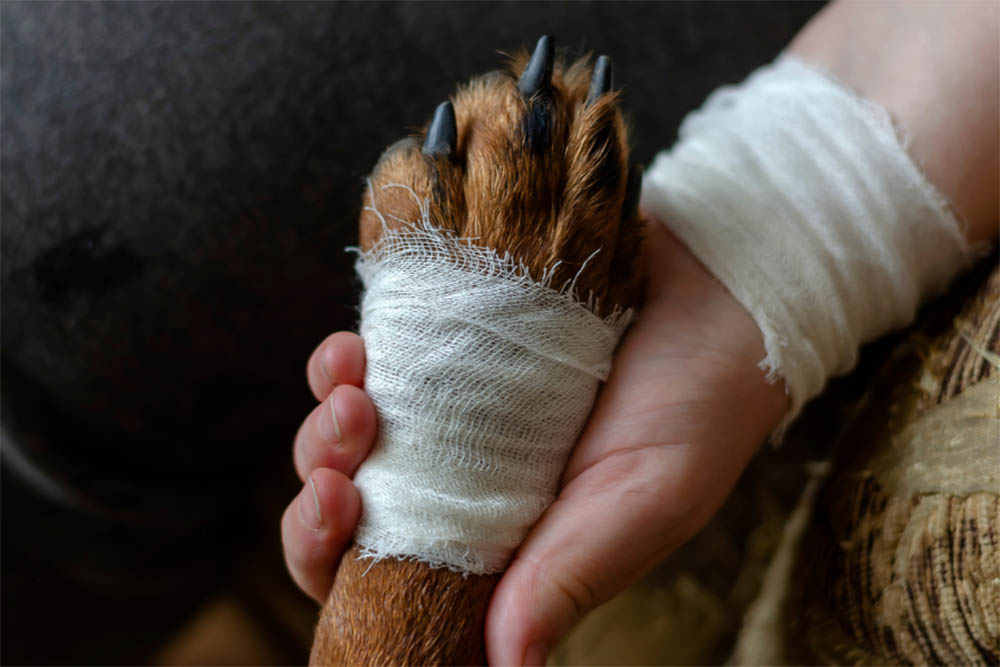
Broken toes are one of the most common injuries seen in dogs. They can occur anywhere and at any moment, as they’re usually the result of an accident.
But the symptoms can often be difficult to diagnose. So, what should you do if you think your dog’s toe might be broken?
This article will help you to determine whether or not your dog has a broken toe and what you should do about it.
How to tell if your dog’s paw is broken
Not all dogs are the same, and therefore they all have different pain tolerances. Dogs that are more tolerant to pain can be the most difficult to diagnose, as they usually hide their symptoms very well.
However, this will depend entirely on your dog’s personality and how he reacts to pain.
For example, when some dogs are injured, they prefer to be left alone and become shy and sometimes even aggressive. While on the other hand, some dogs may seek comfort when they’re in pain and approach you for attention.
They may also bite or lick the injured paw and whimper when weight is put on it.
Even when there are no evident signs of damage, you should consult your veterinarian if you see any of these behaviors in your dog. Some dogs are great at concealing minor injuries, and you may not notice anything is amiss until they start acting strangely.
In addition to these behavioral changes, you should keep an eye out for the following signs if you suspect your dog may have a broken toe:
Limping
The most common symptom of a broken toe is limping. Your dog may show obvious signs of pain when weight is put on it. You’re more likely to notice these signs if your dog has broken its middle or weight-bearing toes.
Depending on how bad the injury is, your dog may become weak and unable to walk on the broken toe at all.
Following an injury, some dogs will lose their appetite totally and refuse to eat any food you have prepared for them.
Similarly, if the injury has not been properly treated and is still causing them distress, they may become lethargic and moody.
Swelling
Swelling is another sign. Although swelling is difficult to detect, particularly if it is subtle, you should check your dog’s paws for symptoms of it if you feel something is amiss.
Before you go ahead and do this, make sure your dog is okay with you touching their paw. When a dog is hurt, it is possible that it will become more aggressive than usual.
Even the most peaceful of dogs can exhibit this behavior, which can be a strong signal that something is wrong.
If your dog is comfortable with you touching their affected toe, do so lightly and look for any symptoms of swelling. If you’re having trouble determining whether it’s swollen, compare the injured toe to the toes on your dog’s uninjured paw.
Swelling is common with serious breaks, and it won’t take long for you to realize something is wrong.
Stop immediately if your dog begins to whimper, cry, or show any other signs of suffering while you examine its paw. You must avoid aggravating the damaged area since this may result in more harm.
But if you can get a good look at your dog’s paw without touching it, you should try to do so. We recommend waiting until your dog is asleep, as this will allow you to thoroughly examine the damaged paw without bothering them.
Licking
If your dog’s toe is broken, you may see it licking its paw. Dogs will do this to try and soothe the pain and comfort themselves. But if your dog is constantly licking and fussing at it, this might aggravate the injury.
What to do if your dogs’ toe is broken
If you’ve already carried out the checks above and you’re certain your dog’s toe is broken, you should seek emergency veterinary help immediately.
Even if you think it’s only a minor fracture, only a vet will be able to determine whether or not this is the case and just how serious the breakage is. The sooner this is done, the sooner your dog can receive the treatment he needs.
If your dog is in a lot of pain, you may find it difficult to get them to the vet.
While a broken toe is a little more manageable than a larger fracture, such as a broken leg, you’ll probably still need to pick them up and load them into the car. Some dogs may find walking tolerable though but will do so with a limp.
You may want to opt for lifting them into your car anyway, as this can prevent further damage and suffering for your dog. We also suggest laying blankets on the seats of your car, especially if the injury is particularly severe.
This prevents the hard surfaces of your car from causing more harm to the damaged paw. You may also want to consider muzzling your dog, as even the most docile of dogs can become aggressive if they’re in a lot of pain.
It’s important to note that if your dog has an open wound, there is no way you can wait. Some of these wounds grow bacteria quickly, and when the bone becomes contaminated, healing becomes extremely difficult.
If you put this off any longer, your dog may become lame for the remainder of his life or even need to have his limb amputated.
A fractured bone may heal with just a cast and a little rest, but you won’t know for sure unless you take your dog to the vet and get him looked at by a professional.
Remember that your dog is similar to a child in that he relies on you to do the right thing. Be a responsible dog owner and take him to the vet.
How are broken paws treated?
Vets treat fractures differently depending on the dog’s age, size, fitness, damaged bone, kind of fracture, and available money. Fracture repairs can cost hundreds of pounds in some cases. Amputation may also be necessary in some extreme cases.
Open, closed, and hairline fractures all need treatment, which is normally done after the patient’s shock, blood loss, and pain have been effectively stabilized with analgesics.
This is when the anti-inflammatories and the danger of infection have been reduced, which can take several days after the initial trauma.
X-rays are usually needed to differentiate between a crack in the bone (where the bone is not totally shattered all the way through) and a fracture.
The x-rays will reveal the problem, offering helpful insight into the dog’s metatarsal or metacarpal bones and their structure
In severe cases, failure to properly stabilize the bones may lead to complications such as fractures that do not heal properly and crooked, deformed toes.
So, pins and metal plates can be used to hold the bone position in dogs with fractures above the knee or elbow. Splints and casts are used to immobilize fractures below the knee or elbow. Joint fractures often need open surgery and repair using pins, screws, and wire.
Generally, if at least one of the weight-bearing toes is not broken, it can be used as a splint to keep the broken toe immobilized and aligned without the need for surgery.
After splinting or surgery, dogs with a broken toe are often prescribed drugs such as tramadol, carprofen, meloxicam, and deracoxib for pain control and to reduce inflammation.
How do dogs break their toes?
Dogs can experience a fractured toe or several fractured toes as a result of different accidents. Smaller dogs are more vulnerable to toe breakages due to their small size and proclivity to be stomped on.
But larger dogs are also at risk too, as falls from heights and badly-judged jumps can also result in broken toes.

If you have a dog that is particularly active and has a tendency to leap around, you should make an effort to protect them from getting hurt.
The best way to do this is by keeping them on a lead in dangerous areas outside and making sure they are not left to their own devices at home.
A well-trained dog is far less likely to get injured. You need to be on the watch if you know your dog has had an accident. A dog can break a toe if a door hits its foot or if it falls when it is running. Nail injuries can also lead to complications.
How to splint your dogs’ injured paw
While this shouldn’t be seen as a long-term solution, using a splint on your dog’s broken toe could help to relieve pain and prevent further damage until you can get your dog to the vet.
You’ll need some supplies from the drugstore and pet aisle and a friend to assist you with the task.
Step 1 – Fit your dog with a muzzle. Any calm dog can and will bite if the toe is causing excruciating pain. A muzzle will keep your dog from biting you or the person helping you.
Step 2 – Get one person to securely hold your dog. Holding food in front of certain dogs will keep their minds off the pain and on the rewards, allowing you to wrap the foot more quickly.
Step 3 – Unravel the bandage and stretch it out a little. This will allow you to tightly wrap the foot without causing your dog to lose blood circulation.
Step 4 – Begin wrapping the foot with the now stretched bandage at the center of your dog’s paw. Wrap the vet wrap around his foot, ankle, and a few inches up his leg. Wrap the foot tightly enough that the toes cannot move. The goal is to wrap the foot such that the surrounding toes act as a splint for the broken toe. There should be no need for tape because the wrap will attach to itself.
Step 5 – Put a cone on your dog if you have one. And be sure to give him a well-deserved treat.
When your dog comes home
Healing is generally faster in younger, quieter, calmer, healthy-eating individuals with single-limb injuries of all shapes, sizes, and breeds.
However, delayed recovery is more prevalent in elderly, bouncy, active, sick, debilitated, giant, or toy breeds, particularly if they have multiple injuries.
Fortunately, fractures do heal, and bones often resume near-normal shape and strength.
Your vet will be able to accurately determine just how long the bone may take to heal. Still, generally canine fractures need a minimum of four weeks in young puppies and eight weeks in older animals to heal sufficiently and eventually return to normal.
Final Thoughts
If you think your dog’s toe may be broken, it’s important to get them help as soon as you can. As bone fractures aren’t always preventable, the best thing you can do for your dog in these circumstances is to get professional advice from a vet.
